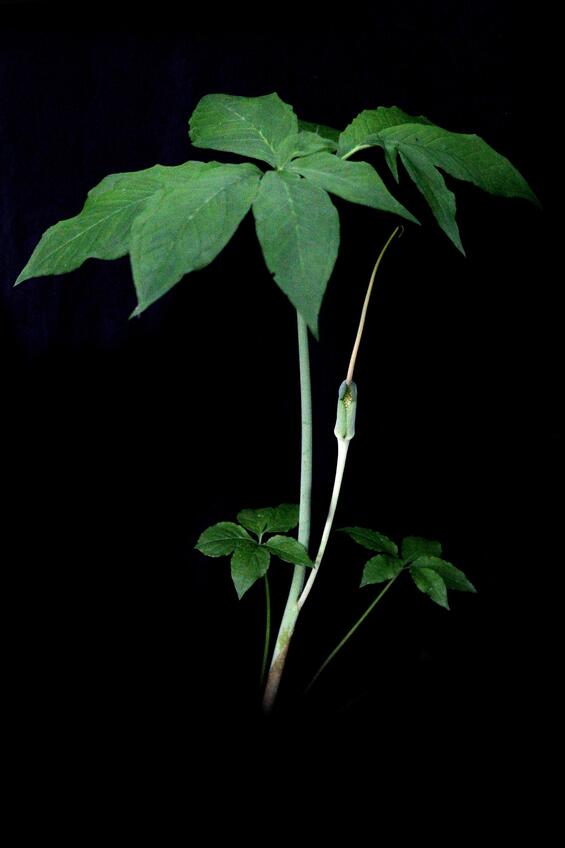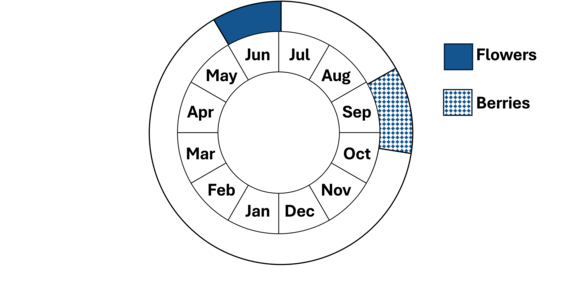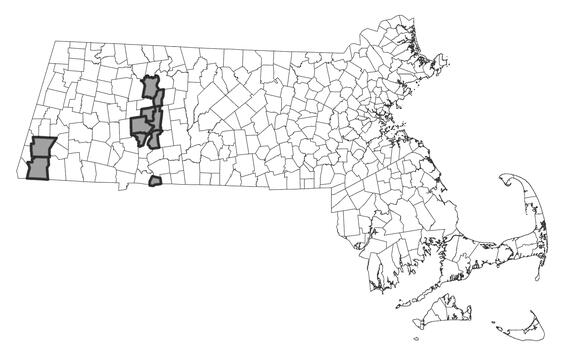- Scientific name: Arisaema dracontium (L.) Schott
- Species of Greatest Conservation Need (MA State Wildlife Action Plan)
- Threatened (MA Endangered Species Act)
Description

Green dragon (Arisaema dracontium) in flower. Image by Chris Buelow.
Green dragon (Arisaema dracontium) is an herbaceous perennial of the Arum family (Araceae). Mature plants stand 30-90 cm (1-3 ft) tall. It produces a solitary, long-stalked compound leaf which can grow up to 1 m (40 in) tall at maturity, though typically is much shorter. Mature plants have 7 to 13 dull green leaflets, which narrow at their base; these are produced along one side of the leaf only. The central leaflets measure 10-20 cm (4-8 in) long while the outer ones become successively smaller. The large green bract that forms a hood (spathe) enclosing the inflorescence is slender, erect, convoluted, pointed, and measures 3-6 cm (1.2-2.4 in) long. The flowering spike (spadix) which has its base surrounded by the spathe, tapers to a long slender point and protrudes 5-10 cm (2-4 in) beyond the spathe. Flowers at the base of the spadix are greenish yellow.
A population of green dragon may be all male or a combination of male and female. Young plants are male but an increase in size and age, poor soil, and low humidity may encourage the appearance of female parts and diminish the male structures proportionately. Berries are orange-red and stand atop the stem in fall after the leaf has wilted.
Jack-in-the-pulpit species (Arisaema triphyllum, A. stewardsonii and A. pusillum), related species, resemble green dragon but have broader spathes which overtop their short spadix. They have only three broad leaflets per leaf. Jack-in-the-pulpit is also a common member of floodplain forests. At one site in Massachusetts, hybrids between green dragon and Jack-in-the-pulpit (A. stewardsonii) have been found, the only such population known.
Life cycle and behavior

Green dragon plants start as a seed in a moist, nutrient rich, floodplain forest. During the first year or two the plants will have only 3 to 5 leaflets in its single leaf, be only 5-15 cm (2-6 in) tall, and develop a below ground tuber. As it grows older, the single leaf will produce more leaflets, and the plant will grow taller. It takes two or more years of growth before it will be mature and produce a flowering stalk. Once it reaches maturity, it will produce a flowering stalk adjacent to and under its the leaf in June. Initially a plant produces only male flowers but in successive years, as it grows older it may start to produce female flowers below the male flowers. The red-orange berry-like fruits, arranged in a slight inverted cone shape, will be present after the leaf senesces, in mid-August to September.

Flower, image by Philip Levin.

Seed, image by Sue Wetmore.
Population status
Green dragon is classified as a Threatened species in Massachusetts. Currently (since 1999), there are 16 sites in Massachusetts where this species has been observed. Of these, only five populations would be considered to have long term viable populations in areas with sufficient habitat. Historically (prior to 1999), green dragon was known from an additional 5 locations, and an additional 5 records are associated only with herbarium sheets that do not have specific locations, mentioning only the town as the location.
Distribution and abundance
Green dragon has a range that covers most of eastern North America, from Ontario and Quebec south to Florida through Texas. It is considered vulnerable in Florida, Kansas, Minnesota, North Carolina, Pennsylvania, and the Canadian provinces. In New England, it is considered Secure in Connecticut, Imperiled in Massachusetts and Vermont, and Critically Imperiled in New Hampshire. It is not known in either Maine or Rhode Island.

Distribution in Massachusetts
1999-2024
Based on records in the Natural Heritage Database
Habitat
Green dragon is found in floodplain woodlands, with open to filtered light, in moist alluvial sites with annual flooding, usually restricted to low lands along large rivers. Associated plants may include silver maple, butternut, cottonwood, green ash, basswood, elm, ostrich fern, wood nettle, grasses, and sedges. Frequently, green dragon occurs at the edges of depressions that fill with water in spring and slowly dry out, though the soil will remain moist. It can withstand being flooded several times a year.
Healthy habitats are vital for supporting native wildlife and plants. Explore habitats and learn about conservation and restoration in Massachusetts.
Threats
One of the primary threats to the survival of green dragon has been conversion of its habitat to agricultural lands. It may also be impacted by changes in hydrology, possibly related to climate change (Staudinger et al. 2024), with more erratic precipitation leading to more frequent and longer floods, and more frequent and severe droughts both of which can kill plants or prevent them from maturing and growing. Other changes in hydrology occur as a result of dams altering flows in rivers. Exotic species within shared habitats are impacting this species, growing so densely that green dragon become shaded out. Finally, off road vehicles are currently causing major destruction in some populations.
Conservation
Survey and monitoring
As with all rare plants, regular surveys to assess the populations are important. One population last observed in 1993, is likely to still exist despite that it hasn’t been observed for over 30 years. Surveying is best done earlier in the season during June before floodplain vegetation grows too dense for accurate surveys. This also gives the surveyor an opportunity to assess the numbers of mature plants, and whether there are any management needs.
Management
Fortunately, with the Massachusetts Wetlands Protection Act in effect, there is less conversion of floodplain habitat into agricultural lands. Exotic species within floodplain forests have become a major problem though and if occurring within or near populations of green dragon habitats, they should be addressed. Finally, it is important to address off-road vehicle impacts to some populations. This may be addressed through signage or blocking of roads that lead into floodplain forests where the populations occur. As with all management in rare species habitat, consultation with MassWildlife’s Natural Heritage and Endangered Species Program, and possibly a permit, is needed prior to the work.
References
Haines, Arthur. Flora Novae Angliae. New England Wild Flower Society, Yale University Press, New Haven, CT. 2011.
Kearsley, J.B. 1999a. Rare and non-Native plants of Massachusetts' floodplain forests. Rhodora 101: 200-205.
Kearsley, J.B. 1999b. Inventory and vegetation classification of floodplain forest communities in Massachusetts. Rhodora 101: 105-135.
NatureServe. 2025. NatureServe Network Biodiversity Location Data accessed through NatureServe Explorer [web application]. NatureServe, Arlington, Virginia. Available https://explorer.natureserve.org/. Accessed: 2/14/2025.
POWO (2025). "Plants of the World Online. Facilitated by the Royal Botanic Gardens, Kew. Published on the Internet; https://powo.science.kew.org/ Retrieved 14 February 2025."
Sanders, L.L. and J. Burk. 1992. A naturally-occurring population of putative Arisaema triphyllum ssp. stewardsonii X A. dracontium hybrids in Massachusetts. Rhodora 94: 340-347.
Staudinger, M.D., A.V. Karmalkar, K. Terwilliger, K. Burgio, A. Lubeck, H. Higgins, T. Rice, T.L. Morelli, A. D'Amato. 2024. A regional synthesis of climate data to inform the 2025 State Wildlife Action Plans in the Northeast U.S. DOI Northeast Climate Adaptation Science Center Cooperator Report. 406 p. https://doi.org/10.21429/t352-9q86
Contact
| Date published: | March 24, 2025 |
|---|